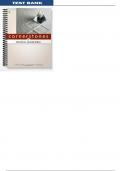Exam (elaborations)
Financial Accounting The Cornerstone of Business Decisions International Edition 2nd Edition by Jay Ri
- Course
- Institution
Financial Accounting The Cornerstone of Business Decisions International Edition 2nd Edition by Jay Ri
[Show more]



